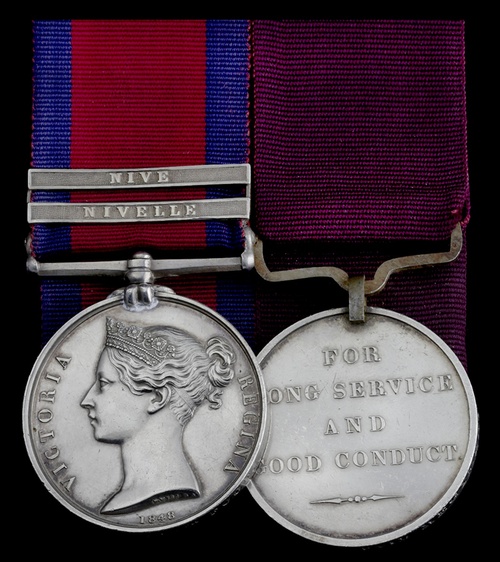
Auction: 19001 - Orders, Decorations and Medals
Lot: 593
Pair: Quartermaster Sergeant Henry Brown, 84th Foot
Military General Service 1793-1814, 2 clasps, Nivelle, Nive (H. Brown, 84th Foot); Army L.S. & G.C., V.R., 1st type (H. Brown, Qr. Master Serj. 84th Regiment Foot. 1839.), fitted with original steel clip and straight bar suspension, edge nicks, good very fine (2)
Provenance:
Spink, March 1995.
Henry Brown was born in 1789 at Kells, County Meath, Ireland. He attested for the 2nd Battalion, 84th (York and Lancaster) Regiment at Auchnacloy, County Tyrone on 25 August 1808. In July 1809, the Battalion embarked at Harwich for the ill-fated Walcheren Expedition, aimed at destroying the French fleet and fortifications around Antwerp. In French hands, Antwerp posed a severe threat to Britain's security. Just a few hours' sail from the Thames Estuary, Napoleon described it as 'a pistol pressed right into the heart of England'. With John Pitt, 2nd Earl of Chatham in overall command, the British amphibious operation involved 40,000 soldiers and 15,000 horses spread over 37 ships of line: a far larger force than Wellington commanded in the Iberian Peninsula. On 31 July the force landed on a swampy, low-lying island at the mouth of the Scheldt called Walcheren. A few years earlier, the French garrison on Walcheren had been forced to withdraw after suffering 80% casualties from malaria. The British fared no better: 8,000 cases of 'Walcheren Fever' were recorded within a month of landing.
Assigned to Lieutenant-General Grosvenor's 3rd Division at Veere, the 84th took part in the siege of Flushing, near Antwerp, from 4 August. Antwerp itself was no longer the British objective, since the French commander, Jean-Baptiste Bernadotte, had strengthened the town's defences and withdrawn the French fleet. Bernadotte then opened the sea sluices around Flushing, flooding the British trenches and batteries. Disease quickly spread among the British soldiers as they stood knee-deep in water for days at a time. Though Flushing surrendered on 15 August, news of the Austrian army's destruction at Wagram (near Vienna) on 6 July left the British in a vulnerable position. The 84th took part in the assault on Bathz on 17 August, but a determined French counter-attack forced them back to Walcheren. By now a Corporal, Brown's Muster Roll shows that he returned to England 'sick' on 16 September. He was promoted to Sergeant on 25 January 1810.
Brown served with the 2nd Battalion, 84th Foot during the Peninsular War, disembarking at Passages on Spain's northern coast on 17 August 1813. Assigned to Major-General Lord Aylmer's 5th Brigade in Sir Thomas Graham's 1st Division, the Battalion encamped behind Vera in the Bidassoa Valley. On 1 September Aylmer's Brigade seized the village of Oyerzum, thus preventing French attempts to relieve the siege of San Sebastian, which surrendered on 8 September. At the Battle of Nivelle (clasp) on 10 November, the 84th attacked the fortified village of Urugne on Marshal Soult's right flank, expelling the French with relatively few casualties. Soult retreated to a line of earthworks above Bayonne, but Wellington turned his flank at the Battle of the Nive (clasp) on 9 December, clearing the way to Toulouse. The Battalion did not see action during the Waterloo Campaign.
Brown advanced to Colour-Sergeant on 25 September 1815 (WO25/503). Following the disbandment of his Battalion in December 1817, he served as a guard aboard the Dromedary, a convict ship bound for New South Wales. The convict guard was commanded by Captain Richard Cruise, 84th Foot, who wrote a detailed account of Dromedary's voyage entitled Journal of a ten months' residence in New Zealand (Longman, Hurst, Rees, Orme & Brown, 1823). Having left the convicts at their destination, Dromedary
Brown re-joined his old Regiment at Cork in December 1821, serving as Quartermaster Sergeant at the 84th's Depot. He served in the West Indies from January 1836, but retired from the Army on 16 May 1839, described as 'affected with asthma and chronic rheumatism', probably resulting from his ordeal at Walcheren. He emigrated to 196 South Second Street, Philadelphia, where his Long Service & Good Conduct Medal was sent via the British Consulate. He died at Amherstberg, Ontario on 16 March 1870, and is buried in the town's Anglican Cemetery; sold with copied research and discharge papers.
Subject to 20% VAT on Buyer’s Premium. For more information please view Terms and Conditions for Buyers.
Sold for
£1,800




